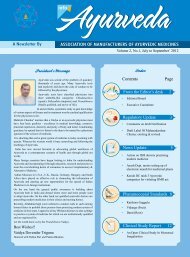OVER VIEW QUALITY CONTROL OF HERBS - amam-ayurveda.org
OVER VIEW QUALITY CONTROL OF HERBS - amam-ayurveda.org
OVER VIEW QUALITY CONTROL OF HERBS - amam-ayurveda.org
You also want an ePaper? Increase the reach of your titles
YUMPU automatically turns print PDFs into web optimized ePapers that Google loves.
<strong>QUALITY</strong> <strong>CONTROL</strong>& ITS APPLICATIONON<strong>HERBS</strong>Dr. Praveen SrivastavaDabur India Limited
What is Quality ? Conformance to requirements Value for Money Fitness for Use Meeting customer requirementsThe totality of features and characteristics of a product that bear uponIts ability to satisfy stated or implied needs
Four Absolutes of Quality The definition of Quality is conformance to requirements The system of Quality is prevention The performance standard of Quality is Zero defects The measurement standard of Quality is the price of nonconformance
Inspection,Quality Control & QualityAssurance Inspection is concerned with sentencing the product as good or bad bycomparison with standard Quality Control is Operational techniques and activities that are used tofull-fill requirements for quality Quality Assurance is planned & systematic actions necessary to provideadequate Confidence that a product will satisfy given requirements forquality Both inspection & Quality Control concentrate their attention on theprocesses of creating the product whereas Quality Assurance anticipate &prevent errors at all points,which could have an impact on the quality ofthe complete ,delivered package associated with product
Cont..Role of Quality Assurance Review and approve all appropriate quality related documents Releasing or rejecting of Raw Materials / Packaging Materials / IntermediateBulks and Finished Products Reviewing completed batch production records and analytical records beforeReleasing the Finished products Making sure that critical deviations are investigated and resolved by takingCAPAs Approving all specifications and Manufacturing Instructions Internal audits (self – inspections ) are performed regularly
Role of Quality Assurance Audit findings and corrective actions should be documented and brought to theattention of responsible person. Agreed corrective actions should be completedin time and effective manner. Quality complaints are investigated and resolved. Equipments Calibration. Materials should be released for use only after satisfactory evaluation, byQuality Assurance. All Processes should be documented and personnel involved in process haveaccess to latest procedures and training imparted•
GMP OrgansDocumentationPersonal HygieneLaboratory ControlMfg. & process areaDistribution & market ComplaintEquipments CleaningGMPSafetyStorage of MaterialBPRs & CheckpointBuilding & FacilitiesPreventive maintenanceProtective Clothing
Quality Control In Traditional SystemsParameters used :of Medicine• Microscopic & Macroscopic examination (Authentication)• Determination of Foreign Matter• Determination of Extractable Matter• Determination of Volatile oils• Determination of Ash Values• Thin Layer chromatography• Determination of Pesticide residue• Determination of Micro Organisms• Determination of Heavy metals• Determination of Bitterness value• Test for tannin/alkaloids/starch
Macroscopic & MicroscopicExamination• First Step in Herbal analysis for identification & to know the degree dof purity.Macroscopic ExaminationBased on shape, size, colour , surface characteristic, texture and aappearance of cutsurfaceExample : Kali MirchFruits are greyish-black to black, hard,wrinkled 0.4-0.5 0.5 cm in dia.odour aromatic;taste pungentTo avoid any same type adulterant microscopicexamination is necessary
Macroscopic & MicroscopicExaminationMicroscopic ExaminationBy Microscopy and /or physicochemical analysis the plant/plant part can beidentifiedMicroscopic examination depends on the morphological type of drug(Leaves,Flowers/Fruits & seeds/powder/barks/roots or rhizome) and d also onthe nature of the material (Entire /cut/powdered)Leaves,Herbs Fruits & seeds Barks&FlowersRoots&Rhizomes
Adulteration or Substitution ofHerbal DrugsTypes of Adulteration or substitution of Herbal DrugsSubstitution with inferior commercial varietiesAdulteration by artificially manufactured substitutesSubstitution by exhausted drugsSubstitution by superficially similar but cheaper naturalsubstancesAdulteration by addition of worthless heavy materialsAddition of Synthetic PrinciplesUsage of vegetative matter from the same plant
Organoleptic EvaluationColorSizeOdour and TasteSurface Characteristic – Texture and Fracture
Macromorphological EvaluationOccurrence or form of the DrugShape of the DrugSurface CharactersTransverse SectionDescription of Aerial StemStudies on Arrangement and Position of LeavesSize and Colour
Evaluation of Leaves or Leaflets• Surface Appearance and Texture• Laminar Structure• Shape of Laminar• Margin• Composition of Laminar• Apex• Base• Venation
Evaluation of Herbal DrugsContaining Flowers• Receptacle of floral drugs• Inflorescence Characteristics• Calyx and CorollaEvaluation of Fruit Drugs• Shape and Size• Types of Fruits
Determination of Solvent ExtractiveValues• Determination of Water Soluble Extractive• Determination of Alcohol Soluble Extractive• Determination of Ash Value• Determination of Acid Insoluble Ash• Determination of Total Solids• Determination of Moisture Content• Determination of Essential Oil
Thin Layer Chromatography• Preparation of the TLC Plate• Preparation and Application of Samples• Determination of Suitable SolventSystems• Development of Chromatogram• Determination of Spray Reagents• Detection of Herbal Drugs and itsExtracts by UV Lights
Test for AlkaloidsAlkaloids are nitrogenous plant excreatoryproducts. These are usually present in plants inthe form of salts of <strong>org</strong>anic acids or associatatewith tannins.Method :Extract 100 mg of the powdered drug with 2 mlof 1% sulphuric acid. Add 1 drop of Dragendorffreagent on the extracts solution. An orangeprecipitate is produced.
Test for GlycosidesGlycosides are non-reducing substances which onhydrolysis, brought about by enzymes or reagents,yield one or more sugars among the products of thereaction.Method :Glycosides are distinguished from one another byphysical properties such as melting-point andoptical rotation, and chemically by the investigationof these products of hydrolysis. Reducing sugars maybe tested for by means of Fehling's Solution.
Test for TanninTannin detected by treating with potassium di-chromate solution (brown colour indicates thepresence of tannin).Tannin : Take 10 g of material (if dry powder) in 100ml water, boiled for half an hour and then filter;make the following experiments :Dilute a few drops of tannin extract with water. Add alittle dil. . NH4OH & then a few drops of potassiumferro-cyanidesoln. . A red colouration appears.
Test for StarchMount the powders in dilute glycerin or waterand then add one or two drops of N/50 Iodinesoln. . keep for few minutes then observe undermicroscope. Blue coloured or blue blackcoloured of the systemetic description of the starchare found.
Test for ResinDissolve 0.1 gm in 10 ml of acetic anhydrideby means of gentle heat, cool and add 0.05 mlof sulphuric acid a bright purplish-red red colour,rapidly changing to violet, is produced.
Common use of herbs with Marker CompoundsName : VasakSc. Name : Adhatoda vasicaMarker Compound - VasicineName : BilvaSc. Name : Aegle marmelosMarker Compound - ImperatorinName : KalmeghSc. Name : Andrographis paniculataMarker Compound - Andrographolid
Name : AmalakiSc. Name : Emblica officinalisMarker Compound – PhycoembellinName : YastimadhuSc. Name : Glycyrrhiza glabraMarker Compound - GlycyrrhizinName : PippaliSc. Name : Piper longumMarker Compound - Piperine
Name : GolmorichSc. Name : Piper nigrumMarker Compound – PiperineName : AswagandhaSc. Name : Withania somniferaMarker Compound - WithanolidesName : ShunthiSc. Name : Zingiber officinaleMarker Compound - Gingerol
Name : Kapoor KachariSc. Name : Hedychium spicatumMarker Compound – Cinamic AcidName : Swet ChandanSc. Name : Santalum albumMarker Compound - SantalolName : NeemSc. Name : Azadirachta indicaMarker Compound - Nimbonone
Name : GhritkumariSc. Name : Aloe barbadensisMarker Compound – AloinName : Ushir/BenamoolSc. Name : Vetiveria zizanioidesMarker Compound - VetivonesName : TulasiSc. Name : Ocimum sanctumMarker Compound – 1,8 Cineol
Determination of Heavy MetalsThe medicinal plant materials can be contaminated with arsenic & heavy metalsWhich can be attributed to many causes including environmental pollution & tracesOf pesticides.As these components even in traces are dangerous ,they have to removefrom the herbal drugs.Limits prescribed by Ayush for Heavy metalsLead (Pb )—10ppmArsenic (As )—NMT 0.1ppmCadmium ( Cd )- 0.3ppmMercury (Hg )—NMT 0.1PPMLimit test for these metals have been prescribed in almost all the PharmacopoeiasAtomic Absorption Spectroscopy (AAS )is used to detect Heavy metals
THANK YOU



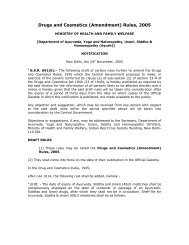
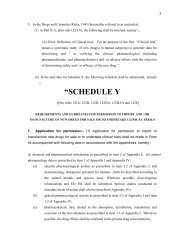
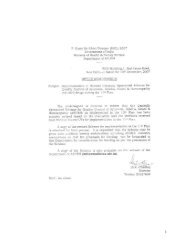

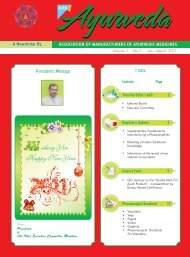

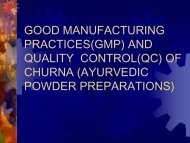
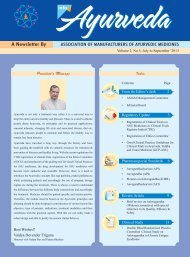
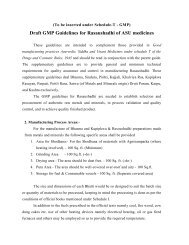
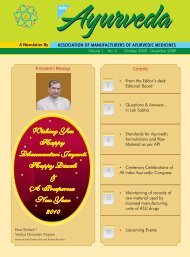
![[To be published in Gazette of India Part II Section 3, sub-section iii]](https://img.yumpu.com/28570283/1/190x245/to-be-published-in-gazette-of-india-part-ii-section-3-sub-section-iii.jpg?quality=85)

